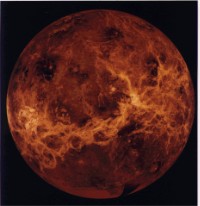
Venus, the second planet out from the Sun, is also the hottest. It is shrouded in thick clouds which contain a lot of sulphuric acid. These acid clouds float on a dense atmosphere consisting mainly of carbon dioxide. The atmospheric pressure is 90 times the pressure on Earth. Venus suffers badly from the " Greenhouse Effect"; its atmosphere traps and holds most of the solar heat that reaches the planet's surface. This makes it even hotter than Mercury, which is a lot closer to the Sun.
We can never see through the Venusian clouds, but the surface has been mapped by radar (by space probe and Earth based stations). Radar scans show that 60% of the surface is covered by huge rolling plains, pock marked with craters. Also there are two distinct highland areas which are 4 to 5 kms higher than the plains which surround them. The highland, known as Ishtar Terra, is comparable in size to Australia. The other highland, Aphrodite Terra, is about twice that size and much rougher. Ishtar Terra has the highest mountain, Maxwell Montes: 11km high (2 km higher than Mt Everest). Venus also has a huge canyon 1 500km long, 5km deep and up to 400km wide; probably a relic of the planet's turbulent geological past. Many extinct volcanoes have been found on Venus' surface, but no active ones - yet.
Venus and Earth are sometimes called "sister" planets. They are similar in size, mass and density; but there are important differences. Earth has water and life. Venus is a scorching hot, dead world - much too hot for any form of life as we know it. Carbon dioxide makes up almost 96% of the Venusian atmosphere and nitrogen almost 4%. The planet has a hard rocky core, surrounded by a mantle and thin surface crust.
Venus has a retrotgrade rotation, it rotates backwards. It spins east-west while orbiting west-east. Uranus and Pluto also have retrograde rotation. The spin and orbit of Venus makes a day on Venus equal to 127 Earth days. Venusian daylight lasts 63.5 days and night 63.5 days.
Venus is usually visible with the naked eye. Sometimes (inaccurately) referred to as the "morning star" or the "evening star", it is by far the brightest "star" in the sky.
Physical Data:
Diameter: 12 104 km
Surface temperature: 475 degrees Centigrade
Minimum distance from Earth: 42 million km
Distance from the Sun: 108.2 million km
Period of rotation: 243 days
Period of orbit: 224.7 days
Number of moons: nil